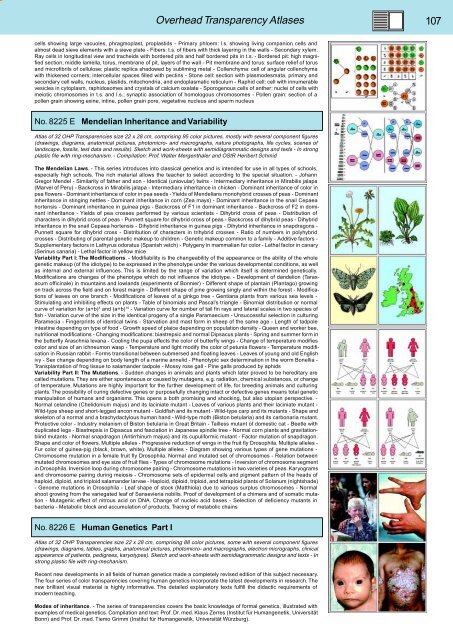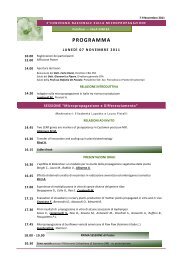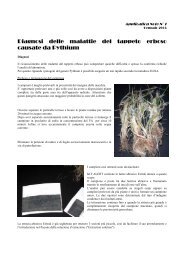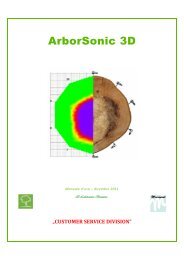BIOLOGY - microscopia.info
BIOLOGY - microscopia.info
BIOLOGY - microscopia.info
You also want an ePaper? Increase the reach of your titles
YUMPU automatically turns print PDFs into web optimized ePapers that Google loves.
Overhead Transparency Atlases<br />
107<br />
cells showing large vacuoles, phragmoplast, proplastids - Primary phloem: l.s. showing living companion cells and<br />
almost dead sieve elements with a sieve plate - Fibers: t.s. of fibers with thick layering in the walls - Secondary xylem:<br />
Ray cells in longitudinal view and tracheids with bordered pits and half bordered pits in t.s. - Bordered pit: high magnified<br />
section; middle lamella, torus, membrane of pit, layers of the wall - Pit membrane and torus: surface relief of torus<br />
and microfibrils of cellulose; plastic replica shadowed by subliming metal - Collenchyma: cell of angular collenchyma<br />
with thickened corners; intercellular spaces filled with pectins - Stone cell: section with plasmodesmata, primary and<br />
secondary cell walls, nucleus, plastids, mitochondria, and endoplasmatic reticulum - Raphid cell: cell with innumerable<br />
vesicles in cytoplasm, raphidosomes and crystals of calcium oxalate - Sporogenous cells of anther: nuclei of cells with<br />
meiotic chromosomes in t.s. and l.s.; synaptic association of homologous chromosomes - Pollen grain: section of a<br />
pollen grain showing exine, intine, pollen grain pore, vegetative nucleus and sperm nucleus<br />
No. 8225 E Mendelian Inheritance and Variability<br />
Atlas of 32 OHP Transparencies size 22 x 28 cm, comprising 95 color pictures, mostly with several component figures<br />
(drawings, diagrams, anatomical pictures, photomicro- and macrographs, nature photographs, life cycles, scenes of<br />
landscape, fossils, test data and results). Sketch and work-sheets with semidiagrammatic designs and texts - In strong<br />
plastic file with ring-mechanism. - Compilation: Prof. Walter Mergenthaler and OStR Heribert Schmid<br />
The Mendelian Laws. - This series introduces into classical genetics and is intended for use in all types of schools,<br />
especially high schools. The rich material allows the teacher to select according to the special situation. - Johann<br />
Gregor Mendel - Similarity of father and son - Identical (uniovular) twins - Intermediary inheritance in Mirabilis jalapa<br />
(Marvel of Peru) - Backcross in Mirabilis jalapa - Intermediary inheritance in chicken - Dominant inheritance of color in<br />
pea flowers - Dominant inheritance of color in pea seeds - Yields of Mendelians monohybrid crosses of peas - Dominant<br />
inheritance in stinging nettles - Dominant inheritance in corn (Zea mays) - Dominant inheritance in the snail Cepaea<br />
hortensis - Dominant inheritance in guinea pigs - Backcross of F1 in dominant inheritance - Backcross of F2 in dominant<br />
inheritance - Yields of pea crosses performed by various scientists - Dihybrid cross of peas - Distribution of<br />
characters in dihybrid cross of peas - Punnett square for dihybrid cross of peas - Backcross of dihybrid peas - Dihybrid<br />
inheritance in the snail Cepaea hortensis - Dihybrid inheritance in guinea pigs - Dihybrid inheritance in snapdragons -<br />
Punnett square for dihybrid cross - Distribution of characters in trihybrid crosses - Ratio of numbers in polyhybrid<br />
crosses - Distributing of parental genetic makeup to children - Genetic makeup common to a family - Additive factors -<br />
Supplementary factors in Lathyrus odoratus (Spanish vetch) - Polygeny in mammalian fur color - Lethal factor in canary<br />
(Serinus canaria) - Lethal factor in yellow mice<br />
Variability Part I: The Modifications. - Modifiability is the changeability of the appearance or the ability of the whole<br />
genetic makeup (of the idiotype) to be expressed in the phenotype under the various developmental conditions, as well<br />
as internal and external influences. This is limited by the range of variation which itself is determined genetically.<br />
Modifications are changes of the phenotype which do not influence the idiotype. - Development of dandelion (Taraxacum<br />
officinale) in mountains and lowlands (experiments of Bonnier) - Different shape of plantain (Plantago) growing<br />
on track across the field and on forest margin - Different shape of pine growing singly and within the forest - Modifications<br />
of leaves on one branch - Modifications of leaves of a ginkgo tree - Gentiana plants from various sea levels -<br />
Stimulating and inhibiting effects on plants - Table of binomials and Pascal’s triangle - Binomial distribution or normal<br />
curve of variation for (a+b) 4 and (a+b) 10 - Variation curve for number of tail fin rays and lateral scales in two species of<br />
fish - Variation curve of the size in the identical progeny of a single Paramaecium - Unsuccessful selection in culturing<br />
Paramecia - Fingerprints of identical twins - Starvation and mast form in sheep of the same age - Length of tadpole<br />
intestine depending on type of food - Growth speed of plaice depending on population density - Queen and worker bee,<br />
nutritional modifications - Changing modifications: biastrepsic and normal Dipsacus plants - Spring and summer form in<br />
the butterfly Araschnia levana - Cooling the pupa effects the color of butterfly wings - Change of temperature modifies<br />
color and size of an ichneumon wasp - Temperature and light modify the color of petunia flowers - Temperature modification<br />
in Russian rabbit - Forms transitional between submersed and floating leaves - Leaves of young and old English<br />
ivy - Sex change depending on body length of a marine annelid - Phenotypic sex determination in the worm Bonellia -<br />
Transplantation of frog tissue to salamander tadpole - Mossy rose gall - Pine galls produced by aphids<br />
Variability Part II: The Mutations. - Sudden changes in animals and plants which later proved to be hereditary are<br />
called mutations. They are either spontaneous or caused by mutagens, e.g. radiation, chemical substances, or change<br />
of temperature. Mutations are highly important for the further development of life, for breeding animals and culturing<br />
plants. The possibility of curing defective genes or purposefully changing intact or defective genes means total genetic<br />
manipulation of humans and organisms. This opens a both promising and shocking, but also utopian perspective. -<br />
Normal celandine (Chelidonium majus) and its laciniate mutant - Leaves of various plants and their laciniate mutant -<br />
Wild-type sheep and short-legged ancon mutant - Goldfish and its mutant - Wild-type carp and its mutants - Shape and<br />
skeleton of a normal and a brachydactylous human hand - Wild-type moth (Biston betularia) and its carbonaria mutant.<br />
Protective color - Industry melanism of Biston betularia in Great Britain - Tailless mutant of domestic cat - Beetle with<br />
duplicated legs - Biastrepsis in Dipsacus and fasciation in Japanese spindle tree - Normal corn plants and gravitationblind<br />
mutants - Normal snapdragon (Antirrhinum majus) and its cupuliformic mutant - Factor mutation of snapdragon.<br />
Shape and color of flowers. Multiple alleles - Progressive reduction of wings in the fruit fly Drosophila. Multiple alleles -<br />
Fur color of guinea-pig (black, brown, white). Multiple alleles - Diagram showing various types of gene mutations -<br />
Chromosome mutation in a female fruit fly Drosophila. Normal and mutated set of chromosomes - Relation between<br />
mutated chromosomes and eye size of fruit flies - Types of chromosome mutations - Inversion of chromosome segment<br />
in Drosophila. Inversion loop during chromosome pairing - Chromosome mutations in two varieties of peas. Karyograms<br />
and chromosome pairing during meiosis - Chromosome sets of epidermal cells and pigment pattern of the heads of<br />
haploid, diploid, and triploid salamander larvae - Haploid, diploid, triploid, and tetraploid plants of Solanum (nightshade)<br />
- Genome mutations in Drosophila - Leaf shape of stock (Matthiola) due to various surplus chromosomes - Normal<br />
shoot growing from the variegated leaf of Sansevieria nobilis. Proof of development of a chimera and of somatic mutation<br />
- Mutagenic effect of nitrous acid on DNA. Change of nucleic acid bases - Selection of deficiency mutants in<br />
bacteria - Metabolic block and accumulation of products. Tracing of metabolic chains<br />
No. 8226 E Human Genetics Part I<br />
Atlas of 32 OHP Transparencies size 22 x 28 cm, comprising 88 color pictures, some with several component figures<br />
(drawings, diagrams, tables, graphs, anatomical pictures, photomicro- and macrographs, electron micrographs, clinical<br />
appearance of patients, pedigrees, karyotypes). Sketch and work-sheets with semidiagrammatic designs and texts - In<br />
strong plastic file with ring-mechanism.<br />
Recent new developments in all fields of human genetics made a completely revised edition of this subject necessary.<br />
The four series of color transparencies covering human genetics incorporate the latest developments in research. The<br />
new brilliant visual material is highly <strong>info</strong>rmative. The detailed explanatory texts fulfill the didactic requirements of<br />
modern teaching.<br />
Modes of inheritance. - The series of transparencies covers the basic knowledge of formal genetics, illustrated with<br />
examples of medical genetics. Compilation and text: Prof. Dr. med. Klaus Zerres (Institut für Humangenetik, Universität<br />
Bonn) and Prof. Dr. med. Tiemo Grimm (Institut für Humangenetik, Universität Würzburg).







